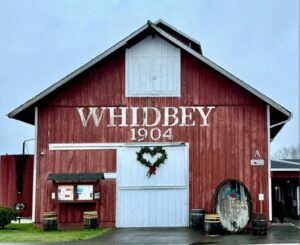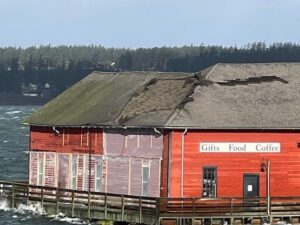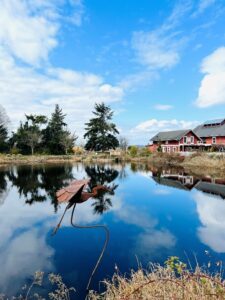Article Courtesy of the Washington Public Ports Association and the Port of Coupeville
Right in the center of Whidbey Island, the town of Coupeville is an idyllic and historic town with a port that works hard to ensure that history is preserved.
At the end of Coupeville’s charming Front Street sits the Coupeville Wharf, which is celebrating its 120th anniversary on July 19. It’s an unmistakable structure: a long wharf jutting out into the waters of Penn Cove with a bright red wooden building situated on top. For the past few decades, the Port of Coupeville has been its steward, and with recent improvements, the port will remain its steward for decades to come.
The Port of Coupeville is dedicated mainly to the preservation of the structures that make central Whidbey Island such a unique place. Its two major properties—the wharf and Greenbank Farm—are major drivers of tourism with powerful connections to the community. Each site houses small businesses that are important to the local economy, as well. Preservation of the century-old buildings at these properties can be an uphill battle. Time and the elements had taken their toll before the port began rehabilitating the wharf.
“When I got [to Coupeville] in 2017, the port had no money for maintenance,” said Port Executive Director Chris Michalopoulos. Though the port collected a tax levy, without any other revenue sources these funds weren’t quite enough to operate the port as well as maintain even one of their properties. The wharf, as a result, had fallen into disrepair.

“We were running out of time,” Michalopoulos said. One day he stood at the end of Front Street and snapped a photo of the wharf building under a king tide, missing siding and a portion of its roof.

It was clear that the port had to act quickly to save the wharf. Michalopoulos secured funding for rehabilitation, applied for grants, and established an Industrial Development District (IDD) in 2020.
“The IDD was the turning point,” Michalopoulos said. The new funding provided by this economic development tool enabled the port to hire staff, bring in project managers, and begin rehabilitation.
The port replaced the wharf’s piles and caps, as well as the roof, water and sewer lines, fuel tanks, siding, seismic stabilization. While much of the structure has been replaced and repaired, Michalopoulos says that the port worked with contractors to “ensure as much of the original wood was saved as possible.” Walk into the wharf building today and you’ll be greeted by pictures of history going back almost 100 years and a marine mammal display, all framed against preserved wood.
This year marks the 120th anniversary of the Coupeville Wharf. The port is hosting an Anniversary Party on July 19, featuring live music, a beer garden, local food vendors, Penn Cove marine life exhibits, a timeline of the wharf’s history, and crafts for kids. Notably, one of the last ships from Washington’s historic “Mosquito Fleet,” the Virginia V, will be docked at the wharf, just as it may have done a century prior. Visitors will be able to tour the historic ship and learn more about that important period in Washington’s maritime history.
Next up on the port’s list is continued rehabilitation of its other property, Greenbank Farm. The farm is a year older than the wharf, and the two sites share a long history. Until the 1950s, it was one of the largest dairy farms on the island, supplying locals as well as the region. While forts Ebey and Casey were being built near Coupeville, dairy products from Greenbank Farm were loaded onto Mosquito Fleet vessels and brought to the Coupeville Wharf to resupply the soldiers working at those sites.
The port took ownership of the farm in 1997. Over the years, they invested in lighting, roofing, climate control, and a new commercial kitchen to support local agriculture businesses and tourism.
While there’s more to do at Greenbank Farm, it’s been returned to beneficial use for the community, including its former role as a working farm. The farm also hosts seasonal community events that bring people together.
“Livestock are back out there – turkeys, chicken, highland cattle, we’ve got dahlia growers and Growing Veterans, a veterans’ farming organization,” Michalopoulos said. “It’s alive, the place is bustling with events and tourism.”
The pond at Greenbank Farm, with farm buildings in the background. The historic barns are a key part of the working farm and are also used for hosting community and private events. Image credit: Port of Coupeville.
Many ports include historic preservation as one of their focus areas, and the Port of Coupeville is unique in that it is currently their main role in the community. The port recently began a broadband project, their first project purely for economic development. But the wharf and farm are still prominent in the port’s mission.
“Coupeville would not be Coupeville without the wharf,” Michalopoulos said. “People come from all around the world to see the wharf. It’s the second most photographed spot in Island County, and a stopping point to that historic structure is Greenbank Farm.
“It’s amazing how many people come back year after year to see the farm and the wharf, and I have the pleasure of hearing people comment on the evolution,” he said. “It means something to them. It means a lot when you see their happiness, the excitement on their face to see the changes.”

This article is adapted from the Washington Public Ports Association “The Manifest” newsletter. For more information about historic preservation & coastal flooding, join for our webinar series August 20 – September 9, 2025




